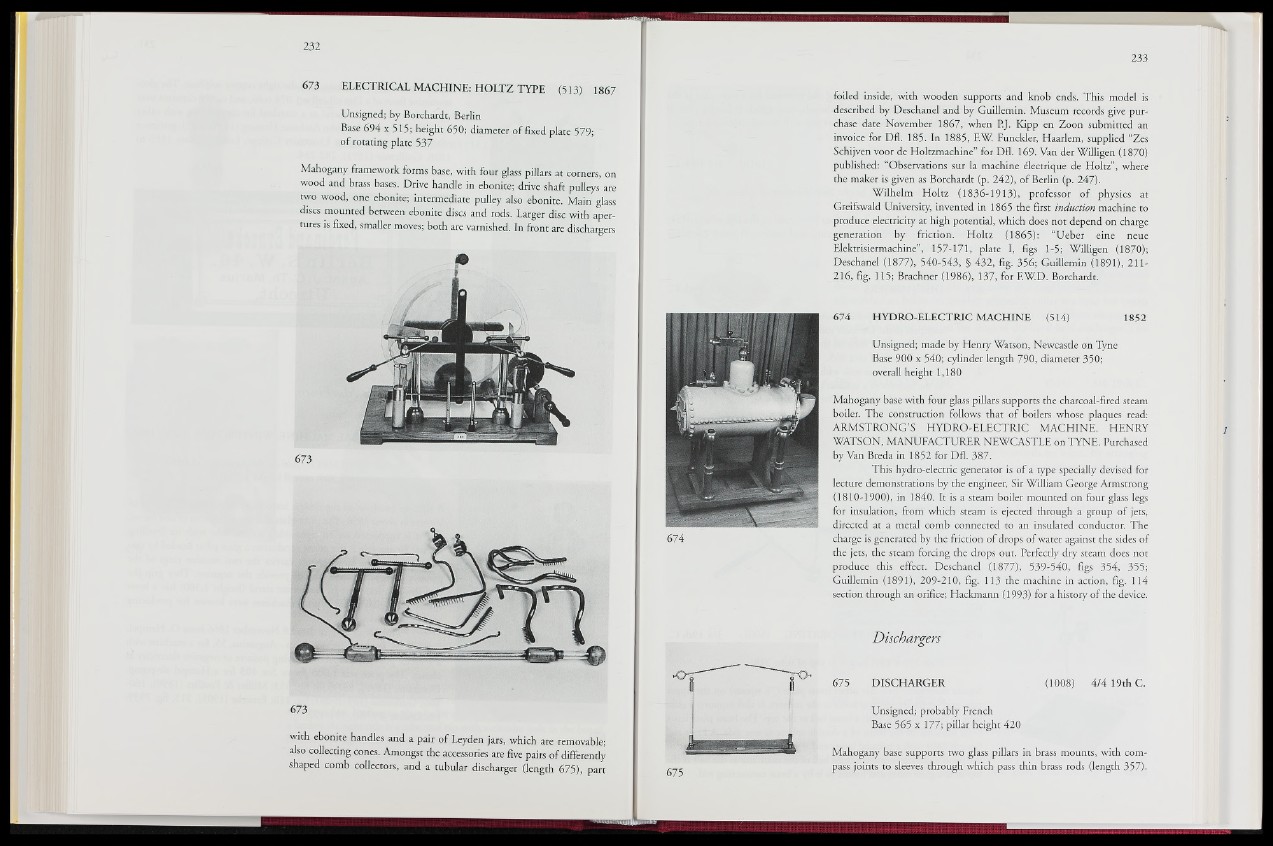
673 ELECTRICAL MACHINE: HOLTZ TYPE (513) 1867
Unsigned; by Borchardt, Berlin
Base 694 x 515; height 650; diameter of fixed plate 579;
of rotating plate 537
Mahogany framework forms base, with four glass pillars at corners, on
wood and brass bases. Drive handle in ebonite; drive shaft pulleys are
two wood, one ebonite; intermediate pulley also ebonite. Main glass
discs mounted between ebonite discs and rods. Larger disc with apertures
is fixed, smaller moves; both are varnished. In front are dischargers
673
with ebonite handles and a pair of Leyden jars, which are removable;
also collecting cones. Amongst the accessories are five pairs of differendy
shaped comb collectors, and a tubular discharger (length 675), part
foiled inside,, with wooden supports and knob ends. This model if
described by Dcschanel and by Guillemin. Museum records give purchase
date NovemberW867, when EjPKipp en Zoon submitted an
invoice for Dfl. 185. In 1885, F.W. Funckler, Haarlem, supplied “Zes
Schijven voor de Holtzmachine” for Dfl. 169. Van der Willigen (1870f
published: “Observations sur la machine electrique de Holtz”, where
the maker is given as Borchardt (p. 242), of Berlin (p. 247).
Wilhelm Holtz (1836-1913|H professor o f physics a f
Greifswald University, invented in 1865 the first induction machine to
produce electricity at high potential, which does not depend on charge
generatioin friction. Holtz f l 8«M | “Ueber eine neue
Elektrisiermachine”, 157-1711 plate I, figs 1-5; Willigen (1870);
Deschanel (1877), 540-543, |f432, fig. 356; Guillemin (1891), 211-
216, fig. 115; Brachner (1986), 137, for F.W.D. Borchardt.
674 HYDRO-ELECTRIC MACHINE (5® # 1 1852
Unsigned; made by Henry Watson, Newcastle on Tyne
Base 900 x 540; cylinder length 790g|liameter 350;
t • .overall height 1,180
Mahogany base with four glass pillatfs supports the charcoal-fired steam
boiler. The construction follows that of boilers whose plaques read:
ARMSTRONG’S. HYDRO-ELECTRIC MACHINE. HENRY
WATSOjj| MANUFACTURER NEWCASTLE on TYNE. Purchased
by Van Breda in 1852 for Dfl. 3’8'7.
This hydro-electric generator is of a type specially devised for
lecture demonstrations by the engineer, Sir William George Armstrong
(1810-1900), -in' 1840:flr is a steam boiler mounted on four glass legs
for insulation, from which steam is ejected through a group of jets,
directed at a metal comb connected to an insulated conductor. The
charge is generated b y « e friction of drops of water against the sides of
the jets, the steam forcing the drops out. Perfectly dry steam does not:
produce this effect. Deschanel (1877), 539-540, figs 35/§jj355;
Guillemin (189|), 209-210, fig. * 3 the machine in action, fig. 114
section through an orifice; Hackmann (1993) for a history of the device.
Dischargers
675 DISCHARGER (1008) 4/4 19th C.
Unsigned; probably French
Base 565 x 177; pillar height 420
Mahogany base supports two glass pillars in brass mounts, with compass
joints to sleeves through which pass thin brass rods (length 357).